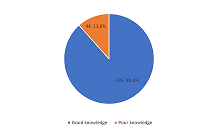Malaria Transmission and Home-based Preventive Practices Amongst Women of Reproductive Age in South-South Nigeria

Abstract:
Malaria infection accounts for over
60% of outpatient visits to healthcare facilities, 30% of child fatalities, 25%
of infant deaths, and 11% of maternal mortality in Nigeria. Notably, in Nigeria,
children under five years of age and pregnant women are especially vulnerable to
malaria-related illnesses and death. The study, therefore, seeks to assess the knowledge
of malaria disease, transmission, and use of home-based prevention strategies amongst
women of reproductive age group. A cross-sectional study design was employed to
assess the knowledge of malaria transmission and home-based preventive practices
amongst a multistage sample of 379 women of reproductive age
seeking healthcare services at the public
PHC facilities in South-South, Nigeria. Data was collected using an interviewer-administered
semi-structured questionnaire. Descriptive and inferential analyses of data collected
were carried out using the IBM SPSS version 20 software. The mean age of the respondents
surveyed in this study was 32.2 (SD ± 6.9) years. Most respondents [88.4% (n = 335)]
had good knowledge of malaria transmission and prevention; however, the majority
were not knowledgeable about the period mosquitoes commonly enter the house (71.5%)
and the peak mosquito biting period (63.1%). There were varied degrees of practice
of the various malaria home-based prevention strategies. In conclusion, a significant
proportion of the surveyed reproductive-age women had some grasp on the fundamental
issues of malaria transmission and prevention with some identified gaps, and they
used different home-based malaria prevention measures at varied degrees.
References:
[1] WHO,
“World Malaria Report 2020 Regional Briefing kit,” Geneva, 2020. Accessed: Jun.
19, 2022. [Online]. Available: https://www.who.int/docs/default-source/malaria/world-malaria-reports/world-malaria-report-2020-regional-briefing-kit-eng.pdf?sfvrsn=3ff894_7.
[2] World
Health Organization., “World Malaria Report 2018,” World Health Organization,
Geneva, Nov. 2018. Accessed: May 31, 2023. [Online]. Available: https://www.who.int/publications/i/item/9789241565653.
[3] M.
Accrombessi and S. Issifou, “Malaria control and elimination in sub-Saharan
Africa: data from antenatal care centres,” The Lancet Global Health, vol. 7,
no. 12. Elsevier Ltd, pp. e1595–e1596, Dec. 01, 2019. Doi: 10.1016/S2214-109X (19)30420-6.
[4] WHO
Regional Office for Africa, “Report on malaria in Nigeria 2022,” 2022.
[Online]. Available: http://apps.who.int/bookorders.
[5] National
Malaria Elimination Programme, National Guidelines for Diagnosis and Treatment
of Malaria, 3rd ed. Abuja: Federal Ministry of Health, Nigeria, 2015.
[6] USAID,
“Eliminating malaria in Nigeria: five ways the USAID’s ‘president’s malaria
initiative for states’ is making a difference,” Apr. 2021. Accessed: Aug. 16,
2022. [Online]. Available: https://www.usaid.gov/news-information/news/eliminating-malaria-nigeria-five-ways-usaid%E2%80%99s-%E2%80%98president%E2%80%99s-malaria-initiative.
[7] World
Health Organization, “World Malaria Report 2021,” Geneva, 2021. Accessed: Jul.
06, 2022. [Online]. Available: https://www.who.int/teams/global-malaria-programme/reports/world-malaria-report-2021#.
[8] National
Malaria Elimination Programme, “National Malaria Strategic Plan,” Abuja, 2014.
Accessed: Jul. 05, 2022. [Online]. Available: https://www.health.gov.ng/doc/NMEP-Strategic-Plan.pdf.
[9] Support
to the National Malaria Programme in Nigeria (SuNMaP), “Malaria control in
Nigeria - Lessons learnt,” Abuja, 2016. Accessed: Jul. 05, 2022. [Online].
Available: https://www.malariaconsortium.org/sunmap/pages/about-sunmap/lessons-learnt.
[10] Support
to the National Malaria Programme in Nigeria (SuNMaP), “Achievements in
insecticide treated net ownership and use in Nigeria, and challenges in
sustaining the gains,” Abuja, 2020. Accessed: Jul. 05, 2022. [Online].
Available: https://www.malariaconsortium.org/.
[11] Edo
State Ministry of Health, “Edo State Government: State strategic health
development plan (2010-2015),” Benin City, Nigeria., 2010.
[12] Edo
State Government, “Edo State Primary Healthcare Development Agency
(EDPHCDA-PHCUOR) Implementation Committee Final Report,” Benin City, Nov. 2021.
[13] G.
Cochran, Sampling Techniques, 2nd ed. New York: John Wiley and Sons, Inc.,
1963.
[14] A. M.
Adebayo, O. O. Akinyemi, and E. O. Cadmus, “Knowledge of malaria prevention
among pregnant women and female caregivers of under-five children in rural
southwest Nigeria,” Peer, vol. 3, p. e792, Feb. 2015, Doi: 10.7717/peerj.792.
[15] R.
Saadeh et al., “Osteoporosis among Postmenopausal Women in Jordan: A National
Cross-Sectional Study,” Int J Environ Res Public Health, vol. 19, no. 14, p.
8803, Jul. 2022, Doi: 10.3390/ijerph19148803.
[16] IBM
SPSS., “Statistical Package for the Social Sciences (SPSS) version 20.0. IBM
SPSS;” 2014.
[17] World
Atlas, “List of Countries by Literacy Rate,” 2020. Accessed: Aug. 22, 2023.
[Online]. Available: https://www.worldatlas.com/articles/the-highest-literacy-rates-in-the-world.html.
[18] F.
Okonofua, L. Ntoimo, J. Ogungbangbe, S. Anjorin, W. Imongan, and S. Yaya,
“Predictors of women’s utilization of primary health care for skilled pregnancy
care in rural Nigeria,” BMC Pregnancy Childbirth, vol. 18, no. 1, p. 106, Dec.
2018, Doi: 10.1186/s12884-018-1730-4.
[19] L. C.
Steinhardt et al., “Effectiveness of insecticide-treated bed nets in malaria
prevention in Haiti: a case-control study,” Lancet Glob Health, vol. 5, no. 1,
pp. e96–e103, Jan. 2017, Doi: 10.1016/S2214-109X (16)30238-8.
[20] O. Amoran, “Impact of health education intervention on malaria prevention practices among nursing mothers in rural communities in Nigeria,” Nigerian Medical Journal, vol. 54, no. 2, p. 115, 2013, Doi: 10.4103/0300-1652.110046.
[21] K. E.
Oladimeji, J. M. Tsoka-Gwegweni, E. Ojewole, and S. T. Yunga, “Knowledge of
malaria prevention among pregnant women and non-pregnant mothers of children
aged under 5 years in Ibadan, Southwest Nigeria,” Malar J, vol. 18, no. 1, p.
92, Dec. 2019, Doi: 10.1186/s12936-019-2706-1.
[22] A. R.
Alhassan, “Pregnant Women and Malaria Preventive Measures: A Case of Tamale
Teaching Hospital, Ghana,” J Trop Med, vol. 2021, pp. 1–9, Dec. 2021, Doi:
10.1155/2021/6150172.
[23] W. G.
Stromquist, “Malaria control from the engineering point of view,” Am J Public
Health, vol. 10, pp. 497–501, 1920, Accessed: Jul. 14, 2023. [Online].
Available: https://ajph.aphapublications.org/doi/pdf/10.2105/AJPH.10.6.497.
[24] C. E.
Bisong and C. M. Dongmo, “Utilization of malaria prevention methods by pregnant
women in Yaounde,” Pan African Medical Journal, vol. 15, 2013, Doi:
10.11604/pamj.2013.15.89.2324.

